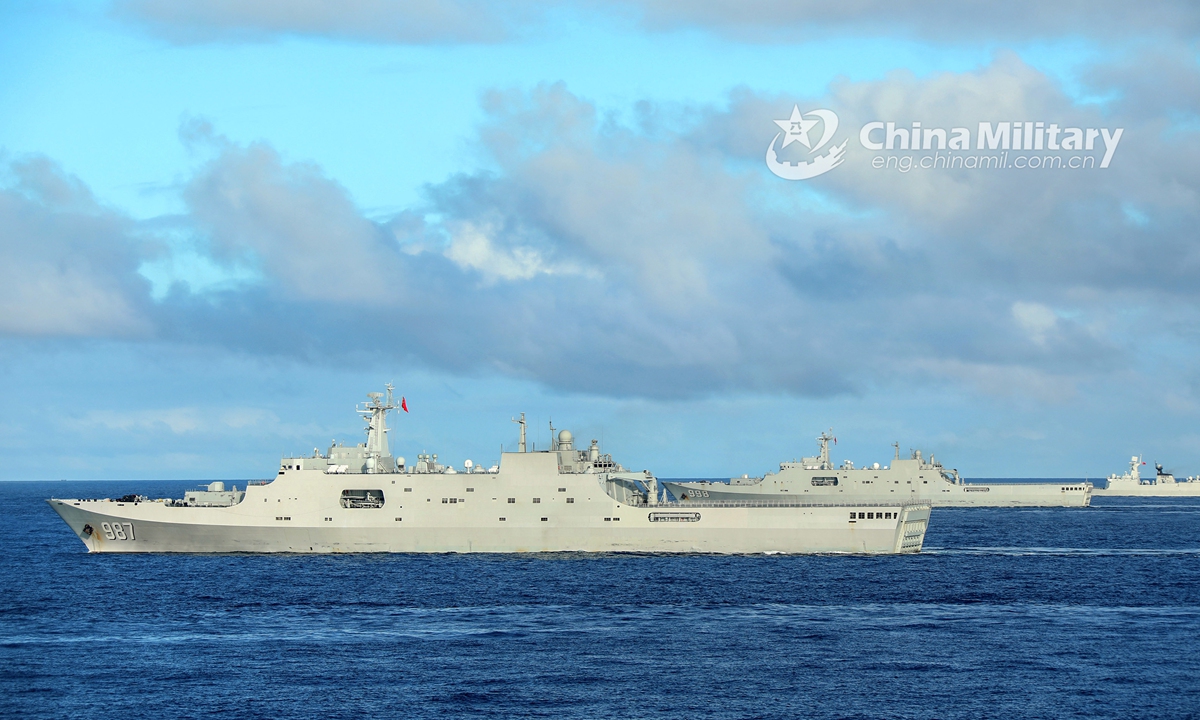
The amphibious dock landing ships Wuzhishan (Hull 987), Kunlunshan (Hull 998) and Changbaishan (Hull 989) attached to a landing ship flotilla with the navy under the PLA Southern Theater Command steam alongside in waters of the South China Sea during a maritime training exercise on November 18, 2020. The exercise lasted four days, focusing on 10 subjects including comprehensive defense, Landing Craft Air Cushion's (LCAC) transfer, visit, board, search and seizure (VBSS) operation, and live-fire operations. (eng.chinamil.com.cn/Photo by Liu Jian)
Australia on Saturday accused a Chinese People's Liberation Army (PLA) Navy flotilla of aiming at laser at an Australian patrol aircraft, calling the move "unsafe," but this only exposes the Australian aircraft's unsafe, provocative close-in reconnaissance on the Chinese ships in the first place, and it is an attempt to throw mud at China when the PLA has been sending assistance to other countries in the region like Tonga and the Solomon Islands, helping them overcome disaster and epidemic, experts said on Sunday.
An Australian P-8A maritime patrol aircraft detected a laser emanating from one of the two PLA Navy vessels, illuminating the aircraft while in flight over Australia's northern approaches on Thursday, Australia's Department of Defense said in a press release on Saturday.
The Australian press release accused the illumination as a serious safety incident, saying the move was "unprofessional and unsafe," and "could have endangered the safety and lives of the Australian personnel."
The two PLA Navy vessels are the Type 052D destroyer
Hefei and the Type 071 amphibious landing ship the
Jinggangshan, according to images released by the Australian Defense Department, which also shows that the ships were sailing in international waters.
They were sailing east through the Arafura Sea at the time of the incident, and have since transited through the Torres Strait and are in the Coral Sea, the press release said.
It is almost certain that it was the Australian patrol aircraft that conducted a close-in reconnaissance on the Chinese warships first, Song Zhongping, a Chinese military expert and TV commentator, told the Global Times on Sunday.
Australia failed to tell the public how close its aircraft flew near the Chinese vessels, so people could not tell if the Chinese vessels were forced to take defensive countermeasures, Song said.
Almost all modern warships are equipped with laser rangefinders, which are a type of measurement tool used to tell distances between objects, an analyst close to the PLA who requested anonymity told the Global Times on Sunday.
They are also used for civilian purposes and are of little danger, the anonymous analyst said, noting that the Australian military knowingly hyped this with the aim of throwing mud at China.
PLA aircraft and vessels have been frequent visitors to the South Pacific recently, as they sent supplies to Tonga for disaster relief and to the Solomon Islands for anti-epidemic efforts.
On January 28, two Y-20 large transport aircraft of the PLA Air Force arrived in Tonga, delivering 33 tons of supplies including food, fresh water, water purifiers and tents to the South Pacific nation, helping it overcome the devastating volcanic eruption and subsequent tsunami.
On Tuesday, the second batch of disaster relief weighing 1,400 tons arrived in Tonga via the Type 071 amphibious landing ship
Wuzhishan and the Type 901 comprehensive supply ship
Chaganhu.
A PLA Air Force Y-20 transport aircraft
on Friday arrived in the Solomon Islands, bringing Chinese anti-epidemic supplies including test kits and oxygen generators weighing over 20 tons, as the country faces a growing number of COVID-19 cases.
Australia does not like China providing concrete benefits to other countries near Australia, so it is finding all ways to discredit China, analysts said.
In the meantime, Australia's largest warship, the HMAS
Adelaide, suffered significant power failures when conducting humanitarian operations to Tonga.




